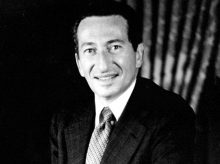In Memoriam – Morris Tanenbaum, inventor of the silicon transistor
Not many people get to say they altered the course of history. But our friend and colleague Morris (Morry) Tanenbaum is one of those select few.
A long-time fixture at Bell Labs, first as a chemist and later as an executive, Tanenbaum is widely regarded as one of the founding fathers of the digital age for developing and demonstrating the first silicon transistor, a contraption that powered the semiconductor revolution and came to define an industry.
On Feb. 26, Tanenbaum passed away peacefully in his home in New Providence, New Jersey. He was 94.
The son of immigrants from Poland and Russia, Tanenbaum was born in West Virginia but spent nearly his entire life in the New Jersey area. He earned a Bachelor of Arts in Chemistry from Johns Hopkins University in 1949 and a Doctor of Philosophy in Physical Chemistry from Princeton University in 1952. (It was there, incidentally, while attending a philosophy lecture, that he first encountered Albert Einstein, dressed in sweats, sitting in on the same class).
Shortly after, Tanenbaum joined Bell Labs. The point-contact transistor was less than five years old, and Tanenbaum was immediately fascinated by whether he could discover a more effective semiconductor than germanium.
He worked methodically, obtaining a variety of materials in their purest form: aluminum, gallium, indium and eventually a rare element called tellurium. Finally, he settled on silicon. Months of work, in which he “grew” a long crystal that could alternate the amount of n-type and p-type impurities, led to his monumental Jan. 26, 1954, demonstration of the silicon transistor at Bell Labs’ Murray Hill campus.
Within a year, the device proved to perform better than any germanium transistor in existence.
“This looks like the transistor we’ve been waiting for. It should be a cinch to make,” Tanenbaum wrote in his notebook.
He was right. The future belonged to silicon.
In its nearly 100 years, Nokia Bell Labs has made groundbreaking innovations in radio astronomy, information theory, optical and cellular communications.
Its researchers have also created the solar cell, the laser, the seminal Telstar satellite, the charge-coupled device and the Unix computer operating system that paved a path to the internet. But perhaps no creation has shaped science and society more than the transistor. It became the foundation of nearly all that followed.
Tanenbaum’s silicon transistor was such a breakthrough because it could operate at much higher temperatures than the existing version made of germanium, which itself was far more efficient than the vacuum tubes that came before.
Silicon, the second most abundant element in the Earth’s crust, was just as chemically reactive as germanium but it was not as sensitive to humidity and was far cheaper to produce.
Tanenbaum’s invention quickly became the world’s preferred semiconductor material. The silicon transistor, which acted as a switch or an amplifier, became the key component in integrated circuits that powered microprocessors and electronic devices manufactured worldwide. Its name naturally led to the famous moniker of a certain Northern California valley.
Tanenbaum’s initial work has progressed so far that today some 30 million transistors can fit on the head of a pin. Today’s transistors are measured in nanometers. For the sake of comparison, a human hair is 90,000 nanometers wide.
For even further perspective, today’s average smart phone is comprised of about 460 billion transistors.
Silicon transistors are so ubiquitous that an estimated 10 quintillion were produced in 2009, for example, about 250 times more than all the grains of rice consumed that year.
And it all began with Tanenbaum’s breakthrough.
Later in his career, Tanenbaum also led a team that invented the first high-field superconducting magnets that are now used in medical imaging devices. He then transitioned to a second career as a senior executive at Bell Labs, Western Electric and New Jersey Bell.
Tanenbaum was chairman and CEO of AT&T Communications at the breakup of the Bell System in 1984 and retired seven years later as chief financial officer and vice chairman of AT&T.
In 2013, he received the Science and Technology Medal at the Edison Patent Awards.
Tanenbaum is survived by his beloved wife of 72 years, Charlotte, his two children, his three grandchildren and five great-grandchildren. He will be sorely missed.

 Contact aron
Contact aron RSS SUBSCRIBE
RSS SUBSCRIBE ALERT
ALERT